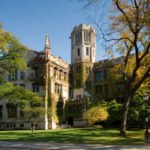My Coursework as an English Major: Real Student Stories
This article was written based on the information and opinions presented by English majors Brooke Elkjer and Katie DiFrancesco in a CollegeVine livestream. You can watch the full livestream for more info.
What’s Covered:
English majors read and write a lot. If you’re interested in majoring in the subject, you should come in with a real love of literature and a passion for dissecting things, big and small, in any given text. An English class is rarely going to be a classic college lecture. Instead, you’re going to have many intimate discussions with a small group of people. In this article, you’ll hear from real students what English classes are like.
Class Structure
General Structure
In a lot of STEM (science, technology, engineering, and mathematics) prerequisites, you’re going to be in a lecture hall with hundreds of people. For English classes at the University of Southern California, the cap is about 19 people. They generally end up being similar sizes. Depending on the instructor’s preference, you’ll get a mix of lecture and discussion—some professors do more lecturing and some prefer a seminar, but they all follow that basic formula.
The length of the classes vary. Sometimes, you’ll meet three times a week for 50 minutes, and sometimes you’ll meet twice a week for an hour and 20 minutes. I’ve never had a real problem with the class size or length of time. Even over Zoom, they’ve worked pretty well.
At Princeton University, most classes are about three hours long and capped at 10 people or fewer. They can also be an hour and a half long and meet twice a week. For this semester, one of my professors decided that three hours would be too hard on Zoom, so we only met for two.
In a more popular class—one that a lot of people want to take—the class size might get up to 200. The structure is a little different as the professor will lecture twice a week for 50 minutes. Then, we break off into what’s called a precept, which is a small, 50-minute seminar where everyone discusses the readings.
In general, the English classes emphasize conversation and discussion of the literature. They depend on those small class interactions to get everybody to dive deep into the readings.
Classes Offered
An English major generally comes with some required courses. These often have to do with the time period in which the works were published—it’s important that students can understand literature through different eras, after all. At USC, you’ll have to take two classes for English before 1800, two classes for English after 1800, and three classes for American literature.
After you fulfill these requirements, you’ll be free to take courses that are more specific to a certain author or literary movement. Some classes, such as children’s literature at Princeton, are quite general and attract many people, but most upper-level English classes will be very specific and small.
Cross-listed Courses
Cross-listing a course means that the class is being offered by two or more different departments. It satisfies the requirements of multiple subjects. Creative writing and women’s studies classes, for example, may be cross-listed with English.
Nonfiction writing classes are different from English classes in subject matter and structure. In those courses, you write some kind of creative nonfiction piece. Memoirs and personal essays are two common genres. They’re similar to your Common App personal statement but longer. Then, in class, your classmates and your professor will offer critiques of your writing. You don’t do this every week—you’ll probably bring in your own work about three times a semester and do a table read and receive feedback.
For some other courses, such as women’s studies, you’ll be in a setting more like a conventional English class. The content will just be different. Instead of literature, you’ll read a dense theoretical text, discuss that in class, and then write analytical essays.



